What I Saw – by Jackie Philpott

In early April I drove over to Berkeley Marine Center, looking for my new-to-me engine. I looked in all the usual places: Cree Partridge’s office, in the corners of the chandlery and in the barn, but it isn’t on site yet. So instead, I interviewed Apo Winprawe and Lowell Harrison regarding their canvas business, Berkeley Marine Canvas. I’ll write what I learned about it next month.
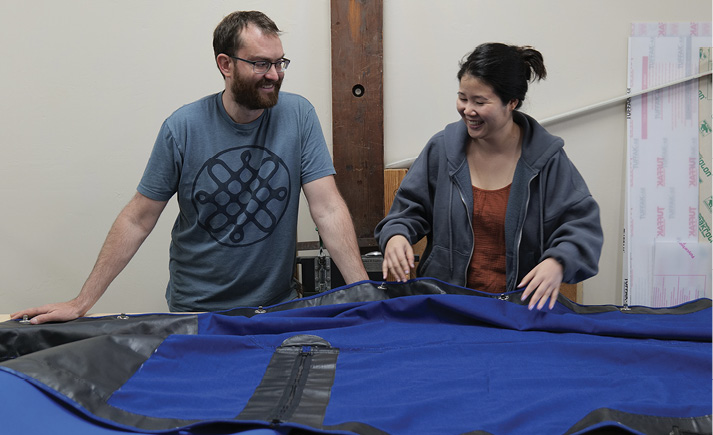
Twilight Zone And Her Owner
On this beautiful spring day, I walked around the boat yard gawking at the boats I recognized. Boats have histories, that’s for sure. And so do people: Who did I see there? It was Paul Kamen with Phil Mummah chatting next to Paul’s boat, which was up on stands waiting for a bottom job.
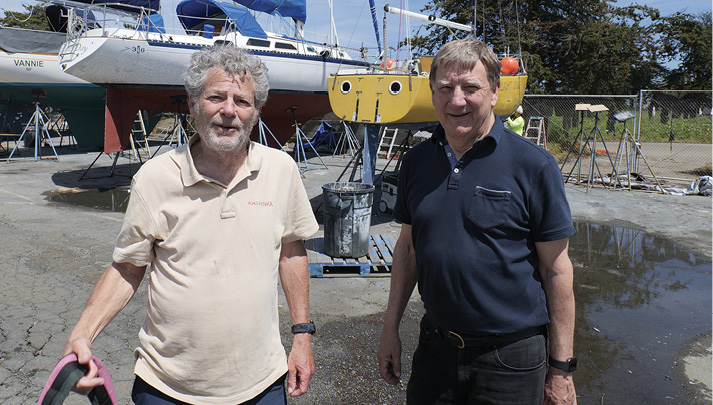
Paul has owned S/V Twilight Zone since 1983. Paul wrote, “I never imagined it would be my last boat…”
As I took Paul and Phil’s photo I asked Paul about the sailing conditions on the Pacific during the year he competed in the Singlehanded Transpacific Race from the San Francisco Bay to Hanalei Bay on the island of Kauai.
“Well, it wasn’t the year to go south,” said Paul. “Jim Fair beat me by four hours.”
In 1986 Paul Kamen on Twilight Zone and Jim Fair on Chesapeake, both 25-foot Merit sailboats, raced against each other in that race. I asked Paul whether the four-hour difference in their finish times was due to Paul sailing south and Jim sailing a… Rhumb line? Here is Paul’s response to that question:
“I went moderately south, but I never saw Jim’s route. He finished about four hours ahead of me. He did much more hand steering, basically all day every day. I only hand steered for about eight hours over the entire race. But I did have a great spinnaker reefing system. It was first use of the “spinnaker thong.” This was long before Yellowbrick, before GPS even, and we both would be hard pressed to plot our own routes with much precision…”
Berkeley Yacht Club has its buoy races every Friday night. For ten years I kept my own boat in the Berkeley Marina, just up from Twilight Zone on O Dock. On my way to my boat to race, I remember stepping carefully past Paul’s jib on the sidewalk. Paul and his crew would be on their hands and knees, covering the most recent holes in his sail with duct tape. By the time I left Berkeley Marina in 2019 that jib sail was mostly silver duct tape. The lesson to me? There is no shame in sailing the boat and the sails ya got.
Seventieth Annual Bullship Race
On April 6 Richmond Yacht Club sponsored the 70th Anniversary of the Bullship Race. What is a Bullship? You may well ask, because it’s a play on words, isn’t it? A tongue twister that could get your ear pulled if you tried to say it five times fast.
The Bullships are El Toros, those tiny little eight-foot dinghies sailed by kids, teenagers and adults since the 1950s.
A few days before the Bullship Race I interviewed Vickie Gilmour at her home in Point Richmond. Vickie has participated in every Bullship Race since she was old enough to do so. In the beginning racers had to be 21 years old. During the course of our wide-ranging conversation, I also got a bit of a history lesson about earlier years of small boat racing on the San Francisco Bay, which is just the way I like conversations to go. Oral history. It’s my favorite kind of sailor conversation. This is what Vickie had to tell me:
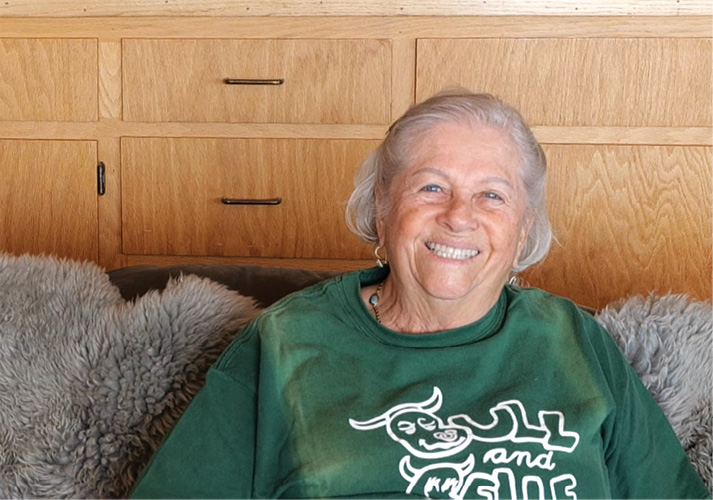
A Short History Of The El Toro
“Richmond Yacht Club was looking for a tender for big boats. Back in the day most boats didn’t have engines. The harbor didn’t have as many fingers because you needed a bigger fairway so boats without engines could maneuver. They were looking for a trainer for kids, a tender for their boats that they could take to the Delta. Richmond Yacht Club families used to primarily sail up to Steamboat Slough and anchor out there for the summer. The guys would go to work during the week and the rest of us would stay up there.
“After many ‘Bull Sessions’, they came up with the design for the El Toro. If you look at the sail insignia? That’s a shovel, a spade shovel. Richmond came up with the design for the El Toro. There were a bunch of people who worked on that. They decided to build 10 or 12 of them. And they built them at the old club. Gordie Rule had a place there and they built El Toros there. They had one jig to build them on. When they were all finished the guys who built them drew straws as to who got which hull. Because they weren’t building their own.
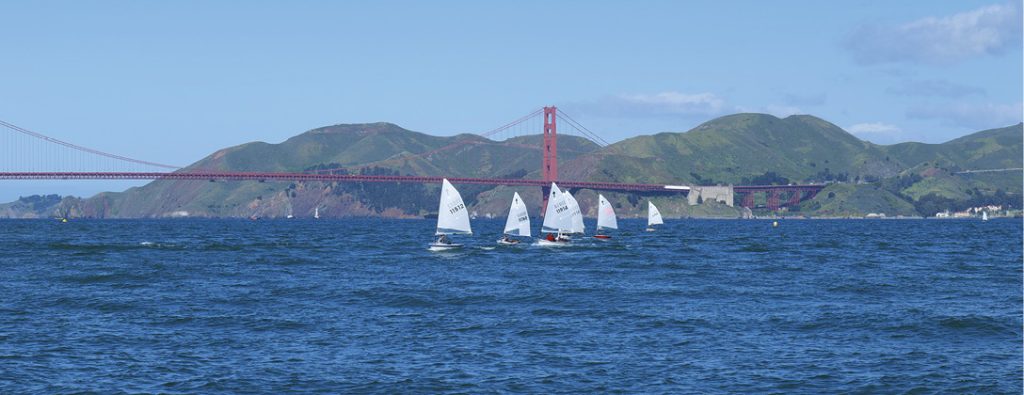
“It can be no heavier than 60# for the hull and 80# with rigging, including the mast and everything. It’s a very strict one design. There is some tolerance. Maybe in the width or the placing of the centerboard trunk. And maybe the thwart and stuff. It has to be stepped on the keel; it has to have splash rails. The sail area must be approximately 49 square feet. And you can have a wooden mast. Masts that are made of wood have grooves built into them.
“Now that they are made of fiberglass all the boats come out exactly the same. There are people who built their own boats, like my father built mine, and you had a jig [sort of template], a skeleton that you would put the plywood over to make sure that the edges and the sides and the angles and the width was all perfect.
“There are probably still some people making them out of plywood. There will be at least one plywood boat, Jim Savattone built a beautiful boat. He lives in Santa Cruz and he’ll be racing it on Saturday.

“It was very popular until some of us grew up and started sailing big boats. Some people might think El Toros are for children. But the El Toro fleet used to be huge. It’s a boat that an adult can sail. And kids can sail.
“We used to carry our El Toros on our backs. Like turtles. Having a dolly is very new. In the last 15 or 20 years I never had a dolly. You didn’t need a dolly. You just put it on your back.
“My father built my first El Toro for me when I was five years old. It was hull #714. Today there are more than 12,000 around the world. There is a fleet in Washington DC, on Long Island Sound, up in Massachusetts. Hawaii has a Bullship Race in Kaneohe Bay. I’ve had five El Toros over the years: Hulls #714, #2254, #4714 is in my garage, #10714 and #11. My current El Toro is Red and its name is Blood Vessel.
“My dad built my El Toro. For some reason, when I was four or five, he decided to take sailing lessons at Lake Merritt. Then he built me a boat and he tried to teach me to sail. He would take me out on the El Toro on Lake Merritt and he’d be sitting on the thwart and I’d be on the back and he’d say, ‘Look at your wake! It’s not even straight! Tiller in the middle! Tiller in the middle!’ I had a death grip on that tiller! Years later we realized that, if I was 35# and he was 135# the rudder probably wasn’t even in the water! We had a good laugh about that. I was trying so hard! Tiller in the middle! I remember that. It frustrated me because I knew it was in the middle but my wake was all over the place.
“I grew up at Lake Merritt. Every weekend we were down there, a whole bunch of us kids. In the summer we were down there every day. My mom or dad would drive me there. A whole bunch of us met up there. We had a system: There was a pay phone there. If we needed to talk to our parents, we’d drop the nickel in, we’d dial up the phone, we’d let it ring once and then we’d hang up. Our parents knew to call the pay phone and we’d get our nickel back.
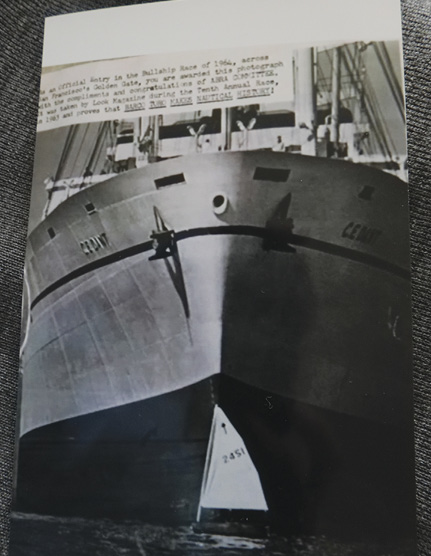
“There are going to be two guys in the race on Saturday with wooden El Toros: Jim Savatonne, and Tom Tillotson, who still has his wooden boat, but he has a fiberglass mast. We all grew up together at Lake Merritt. Peggy Darnall, who helped me print the Bullship t-shirts earlier today grew up there with us, too. She has my original El Toro hull #714 in her garage.”
The Bullship Race
I ask Vickie why she thinks this particular boat, and this particular race, has endured for all these years.
“It’s a challenge to say. I sailed an 8-foot dinghy across the Golden Gate.”
Here is a copy of the photo of an El Toro taken by LOOK magazine in 1964 to commemorate the tenth year of the Bullship Race. Vickie told me about the day the photo was taken:
“We were kids. This photo is of my boyfriend’s boat, hull #2451, taken in front of the CE Dant. His boat was borrowed by an adult because we weren’t old enough to race. The CE Dant was owned by the Dant family. My boyfriend’s father, Mr. Barthrup, was the head of the shipping company. Mr. Barthrup knew that the ship was coming into the gate. Somehow, he communicated to the captain of the ship about how his son’s boat was gonna be out there and they’d better not hurt any little sailboats they see. So, SUPPOSEDLY they backed down for 15 minutes, so as to slow down and not run into the El Toros.
“The El Toro is a great little boat for everybody in the family. Adults can race it, and juniors and little kids. We used to have so many El Toros racing when I was a kid. The older guys would complain about the kids racing against them and beating them. They’d say, ‘They don’t weigh as much, that’s why they’re beating us.’ Then when we became juniors and seniors the little kids didn’t want to race against us cuz we were older and better than them.
“We race through the fog. I don’t use GPS (global positioning system) on my El Toro. GPS is very new and modern. Plus, we have the cowships around us. A cowship is a safety boat that is looking after the bullship boats. They’ll be out there. We’ve got about eight of ‘em this year. The Coast Guard requires us to have one safety cowship for every four El Toros and we try to keep it at three.
“If you have an ebb and the westerly hasn’t come in, you can get flushed out the gate. That has happened to me. You just go with the flow. This year there will be a flood. There’s current maybe, but no wind forecast so there probably won’t be any waves. I’ve gone out as far as Mile Rock. It was flat water going out there. And the cowships were rounding up everybody. So, you just toss ‘em your line when they come to you and you get towed.
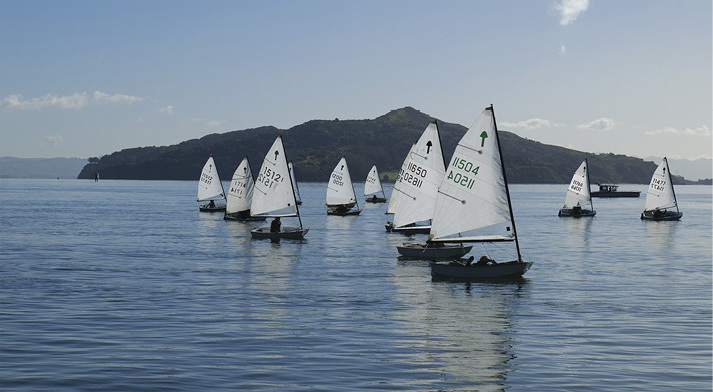
“In the early years of the race the Buena Vista Café supplied Irish Coffee at the end of the race. And that’s why you had to be 21 years old to race it. Because you wouldn’t want to be giving alcohol to kids. Because otherwise all of us kids would have been out there racing. And a lot of the adults wouldn’t have been out there because they were borrowing our boats to do the race.
“When the Buena Vista stopped serving the Irish coffees the adults contracted with the St. Francis. Then they decided you could be 18 or older to do the Bullship Race.
There used to be a race called the El Toro Stampede. The El Toro Stampede was done by Richmond Yacht Club. And then the El Toro Roundup and Flight of the Bulls were sponsored by the Lake Merced Sailing Club.
“My most memorable Bullship Race is the one I won. I’ve only won once. I beat out Jim Morefield and everybody else. My win represented science and skill versus fear and superstition.
“Hank Jotz probably won the race more than anyone else.”
I asked Vickie about what forecast to expect on the approaching Saturday event. She was relatively nonchalant and said:
“Unless it’s blowing 25 knots I DON’T expect anybody to capsize out there. And if they do? The fiberglass boats float pretty high because they have built in flotation in the side tanks. And of course, you can turtle anything. Although I don’t think I’ve ever turtled an El Toro. If they need a tow they’ll probably sit in their boat and bail the water out and throw a line to a mothership.”
Crew On A Mothership DURING the 2024 Bullship Race
I was invited to be crew on a “mothership,” a boat that would be used to shepherd the El Toros as they raced each other across the Bay from Sausalito to the San Francisco Small Boat Harbor.
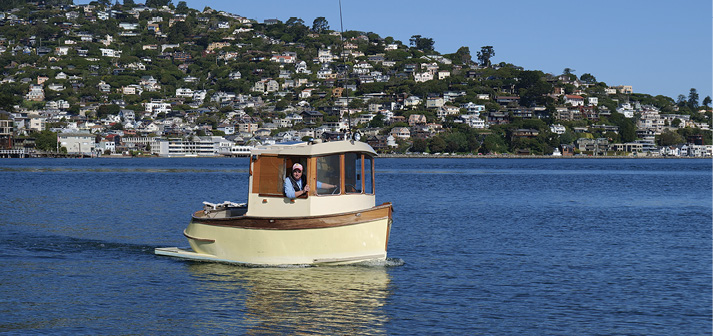
Our mothership was the only sailboat on the course, and we were fully prepared to save any El Toro sailor who needed saving. The morning of the race we went over our safety plans carefully. We had three boat hooks on board in order to fish people out of the water. We talked about how to attach the ladder to the starboard side of the boat and tied a tow line to a cleat at the stern of the boat. We were ready to roll. None of that was necessary, though, because the day offered perfect conditions for little boats: There was a blue sky, a gentle breeze and no call for our three boat hooks.
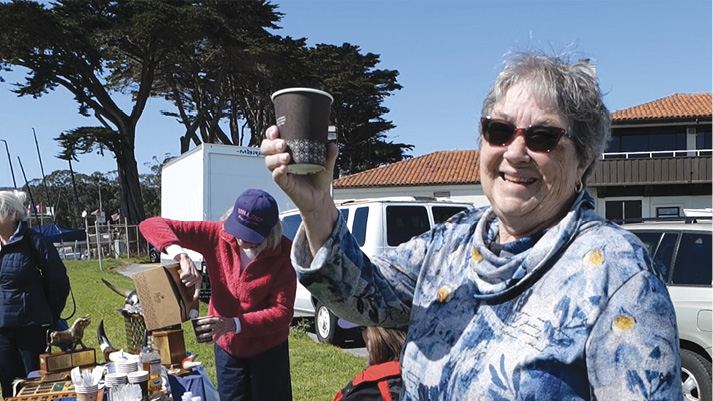
Waiting at the end of the race, at the entrance to the harbor, the Bullship race committee captured finish times and shook a loud cowbell as each boat finished. Cinde Lou Delmas S/V Another Girl had made arrangements for all our race and support boats to tie up at the St. Francis Yacht Club. Thank you to the dockmaster, who made sure that he greeted us all courteously and our boats were tied up properly.
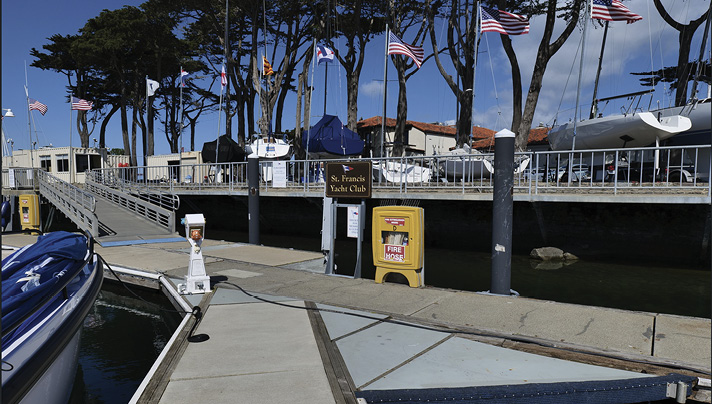
When everyone had arrived Peggy Darnall, Victoria Hartsock and her husband Gary Hartsock were waiting behind a table on Marina Green near the St. Francis Yacht Club. They were ready to provide bottomless cups of Peet’s coffee and a big sheet cake, providing needed nourishment and caffeine to all the sailors, mothership crew members and the dozens of supporters.
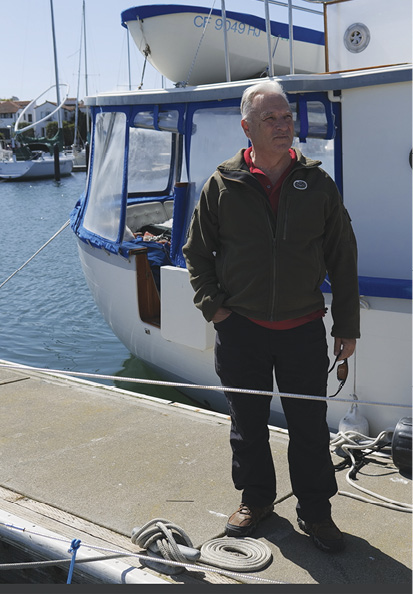
While people crowded around the table I talked with Gary, who explained that he and Victoria are members of the Lake Merritt Sailing Club. Gary has done the Bullship Race many times, but not this year. I asked him to describe the characteristics of a successful El Toro sailor.

His response? “Well, lightweight is better, and you have to be sort of gutsy. And you should probably know how to swim.”
A cavalier response to a dangerous activity? Not at all. His attitude is a testament to the safety-first attitude of self-sufficient singlehanded sailors everywhere.
Thank you to Ornaith Keene and John Dukat for many additional details that added depth to this story.
Up The Napa River
A sailing friend, for privacy’s sake let’s call him Captain, mentioned that he planned to take his 30-foot sailboat up to the Napa Valley Marina for a bottom job. Never having sailed up that way, I asked to come along. “Sure,” said the captain. Then I asked to bring along another sailing friend, let’s call him the crew, and the captain said, “sure.” So, there we were, motoring out of Richmond Marina with a brand new shiny outboard on the transom. It was a lovely day on a Friday morning. La la la, weren’t we having the nicest time? San Pablo Bay was a flat blue, reflecting the sky.

The sun was shining, the San Pablo Bay was shimmering and there were just enough things to look at, like that delivery boat towing a little pontoon plane. That was the kind of plane that you need to park next to your boat when you want ice from Pirates Lair. Yeah.
We entered Mare Island Strait and shared stories about struggling against the ebb tide at the end of Vallejo races. Ha ha ha. What did we care today? We were in the flood. We called ahead to a very pleasant bridge operator who opened the bridge for us. He hung over the rail and waved as we motored through. Only six more miles or so to the target marina.
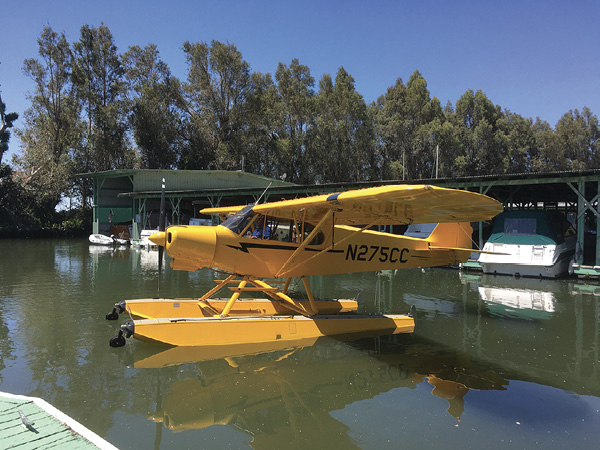
Just past the bridge, as we turned back to watch it close behind us, our outboard stopped running. No big noise, no line tangled ‘round the prop’, the engine just went from sounding wonderful to quiet. Sounded like it ran out of gas. Huh? Yes, that’s what happened.
The captain said, “Oh damn. Last time I motored up here that’s all the gas I needed. Guess I used my smaller motor last time.”
No problem. We’re on a sailboat! The wind is directly behind us, so we raise the main, then the spinnaker. As soon as the spinnaker is up the wind clocks around to port. We notice that the ebb is pushing us back toward the bridge, so the crew runs up to the bow and throws the anchor over. We sit and drink water, eat the Raley’s sandwiches that have been brought along. Thanks, Crew!

Time to reconnoiter. Turn around, ride the ebb back through the bridge and get gas at Vallejo Marina? Nah. We’re sailors. How hard can it be to sail upriver? Plus, look! There’s wind up ahead. And here it comes, right on our nose. Huh. Well, we know how to tack. How hard can it be to get up a (long, winding, increasingly narrow) river? This is an adventure!
So, that’s what we did for the next four hours. And when the wind grew to 20+ knots? We tacked and heeled waaaay over and then tacked again. And yes, we did, go aground at the infamous Marker #7, but that was nothing compared to what lay ahead. While we were grounded we ate lemon bread, and then we rocked right out of there and kept going. Because that’s what you do when you’re self-sufficient, right?
As we got closer to the marina there were houses and docks to port. Tied up to the docks were boats. There were motorboats, houseboats, multi hulls and monohulls. Now, the crew was at the helm while the captain and I scrambled back and forth sheeting in, grinding hard and breathing heavily. The wind built and it was still on the nose. We tacked at least 40 times. Fifty times. Maybe we tacked 200 times.
We were making way, albeit slowly, in one last push toward the Brazos Bridge. Out of the corner of our sweat-drenched eyes we saw a fishing boat anchored on the eastern edge of the river in the shade of the bridge. Three fellas were reclined in their comfy marine-grade vinyl seats, feet up, cold drinks in hand, their fishing poles trailing in the ebb. They were watching us, waiting to see whether we would make it through the narrow span.
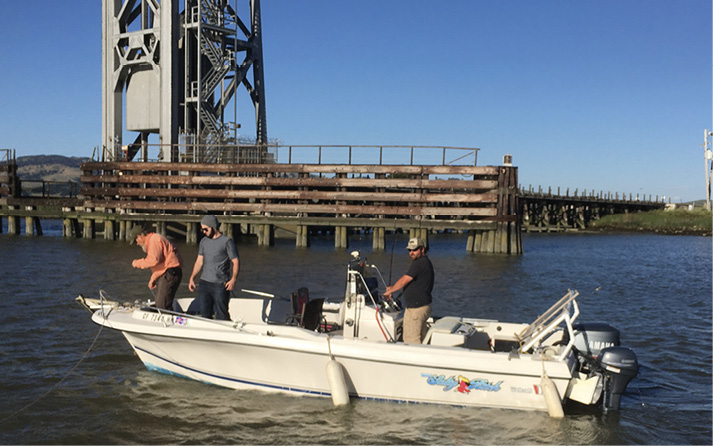
And we tried. Really, we did. There we were, tacking to port in big wind. The depth finder read 45 feet until it didn’t and we just stopped. Hard. That mud reached out and grabbed our sweet little boat and held it fast. The depth goes from 45 feet to 0 feet of water on the port side of the Napa River just before the bridge. Please take note of this for future reference. Yeah, right there.
So, the captain did what smart captains do: He ran up to the bow and threw that anchor overboard again. His crew lowered the main and we all wrestled it into some sort of order. Then we sat down, drank lots more water and ate the rest of the lemon bread. Sustenance is a sugar high.
We didn’t have a raft and none of us had renewed our BoatU.S. towing insurance, so we considered our choices carefully.
So, we sat there and watched the fishermen, and the fishermen watched us. I think they may have been laughing at us, but they weren’t being obvious about it. Thankfully. We were hot and sweaty and resigned to waiting for the next flood. We were keeping a watch out for alligators. Or pythons.
After a while, when it became clear that they weren’t catching any sturgeon over on the other side of the river anyway, the three fishermen motored over and asked if we needed help. The captain and crew were reluctant to admit that we did, but finally we said something like “Since you mention it, thank you, that would be very much appreciated. Could you tow us into the marina?” And their response was “Sure.”
Because they are generous people, fishermen in their boats. Then they used a lot of muscle and fuel to pull first our anchor and then our boat out of the mud, and they towed us the short distance into the Napa Marina.
So, thank you again to the Salty Bitch and especially her skipper, who seemed to really know how to handle her. One of his companions said it was the first time he had been on the Napa River, the first time he had fished for sturgeon. Now, he has another story to tell, as do I. And this is the end of it.
This coming weekend I will drive over to watch the PICSA regatta, which will be hosted by Encinal Yacht Club in Alameda. PICSA is an acronym for the Pacific Interscholastic Sailing Association, in which high school sailing teams compete. And guess which high school team is in first place? My alma mater! Mater Dei is a Catholic high school in Southern California. When I went to school there, they didn’t even have a sailing team. I’m sort of excited and will let you know all about it. I’ll take lots of photos of kids having fun. I’ve never spent much time at Encinal and I’m looking forward to visiting.
In the meantime, enjoy your time on the water and please write to tell me about your own boating experiences. I can be reached at jackie@yachtsmanmagazine.com
Thank you for reading Bay & Delta Yachtsman, and let’s all be careful out there.



